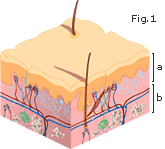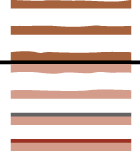 Leather
is the first choice of upper material forwet
conditions. For mountain boots tanners use only
south German bull hides as only hides of adult
animals of this origin have the required thickness.
These hides can be split into two layers. Grain
leather (ref a of fig. 1) is the outer
surface of the hide and is the toughest and
most water resistant as it has very close cell
structure which already has a natural water
resistance and strength. The inner surface is
split leather (ref b of fig
1), generally used to make suede, Baycast and
other more economical leather types.
Leather
is the first choice of upper material forwet
conditions. For mountain boots tanners use only
south German bull hides as only hides of adult
animals of this origin have the required thickness.
These hides can be split into two layers. Grain
leather (ref a of fig. 1) is the outer
surface of the hide and is the toughest and
most water resistant as it has very close cell
structure which already has a natural water
resistance and strength. The inner surface is
split leather (ref b of fig
1), generally used to make suede, Baycast and
other more economical leather types.  Not
all parts of the hide can be used for making
mountain boots due to different thicknesses
and consistency of the hide. Only the butt area
is used (fig. 2) All types of leather can be
treated for water repellency during the tanning
process but all tough leathers should still
be treated during use of the boots to maintain
or restore water resistance. This should be
done by waxing them with the correct natural
waxes. Synthetic waxes can soften the structure
of the leather and make your boots too soft.
Not
all parts of the hide can be used for making
mountain boots due to different thicknesses
and consistency of the hide. Only the butt area
is used (fig. 2) All types of leather can be
treated for water repellency during the tanning
process but all tough leathers should still
be treated during use of the boots to maintain
or restore water resistance. This should be
done by waxing them with the correct natural
waxes. Synthetic waxes can soften the structure
of the leather and make your boots too soft.
 The
hide is split in two layers.
The
hide is split in two layers.
From the upper part we obtain grain leather,
from the inner surface split leather.
Grain leather
can be left natural and this gives
Full Grain Leather.
If the surface is specially buffed to give it
a velvety finish we obtain Nubuck
Leather. Split leather can be
shaved to obtain suede or coated with polyurethane
to obtain a coated leather or also treated with
finishing products to give the split leather
all kinds of different characteristics.